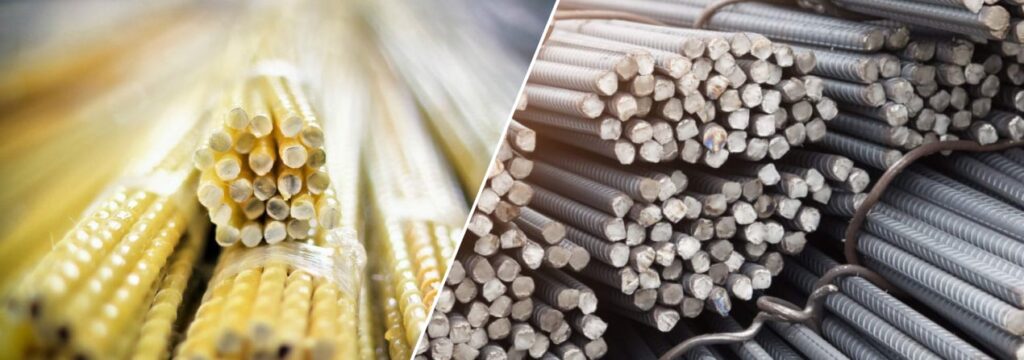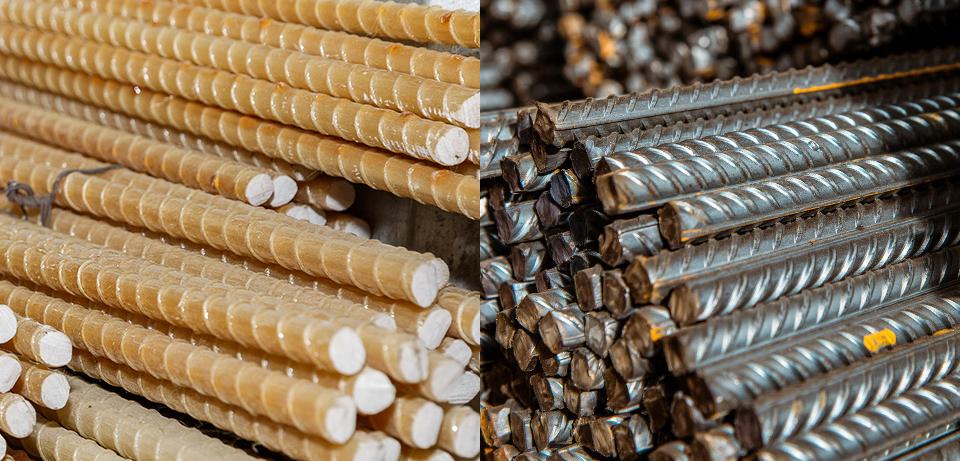في قطاع البناء سريع التطور، يبرز حديد التسليح المقوى بالبوليمر المقوى بألياف الزجاج (GFRP) كبديل ثوري لتسليح الفولاذ التقليدي. وبينما شكّل الفولاذ العمود الفقري للخرسانة المسلحة لأكثر من قرن، إلا أن محدودية التآكل والوزن وتكاليف الصيانة طويلة الأمد دفعت المهندسين والمقاولين إلى استكشاف بدائل غير معدنية.
يقدم حديد التسليح المصنوع من البلاستيك المقوى بألياف زجاجية، والذي يتم إنتاجه من ألياف زجاجية عالية القوة مدمجة في مصفوفة بوليمرية، مزيجًا فريدًا من البنية خفيفة الوزن ومقاومة التآكل والموثوقية الميكانيكية، مما يجعله مثاليًا لمجموعة واسعة من التطبيقات، من مشاريع البنية التحتية إلى البيئات البحرية والجسور والمصانع الكيميائية.
في هذه المقالة، نُقدّم مقارنة شاملة بين GFRP وتسليح الفولاذ، مدعومةً ببيانات واقعية واختبارات معملية ورؤى سوقية. كما نستكشف المزايا الاقتصادية وفوائد التركيب وعوامل الاستدامة التي تجعل GFRP الحل الأمثل لتسليح الخرسانة.
محتويات
ما هو حديد التسليح GFRP؟
قضبان التسليح المقواة بالبوليمر المقوى بألياف الزجاج (GFRP) هي مادة مركبة مصنوعة من حزم من ألياف زجاجية عالية القوة مشبعة بإستر الفينيل أو راتنجات الإيبوكسي. والنتيجة هي بديل قضبان تسليح غير قابل للتآكل، وخفيف الوزن، ومتين، لا يصدأ أو يتآكل بمرور الوقت، حتى في البيئات الغنية بالكلوريد أو القلوية.
الخصائص الرئيسية لـ GFRP:
- ¼ وزن الفولاذ
- قوة الشد 2x مقارنة بالفولاذ الصلب
- غير مغناطيسي وغير موصل للكهرباء
- Completely مقاوم للتآكل
الفولاذ مقابل البلاستيك المقوى بألياف الزجاج (GFRP): مقارنة فنية
| ملكية | حديد التسليح | حديد التسليح المقوى بألياف زجاجية |
| قوة الشد | ~450 ميجا باسكال | 800–1200 ميجا باسكال |
| معامل المرونة | ~200 جيجا باسكال | 40–60 جيجا باسكال |
| وزن | 1x | ~0.25x (75% أخف وزناً) |
| مقاومة التآكل | عرضة للصدأ | 100% مقاوم للتآكل |
| الموصلية الحرارية | عالي | منخفض جدًا |
| الموصلية المغناطيسية | مغناطيسي | غير مغناطيسي |
| مقاومة التعب | واسطة | عالي |
بينما يتميز الفولاذ بصلابة عالية وسهولة في الاستخدام، إلا أن له عيوبًا كبيرة في البيئات القاسية. أما البلاستيك المقوى بألياف الزجاج (GFRP)، فرغم مرونته القليلة، يبقى مستقرًا في المياه المالحة والمواد الكيميائية والبيئات الرطبة، مما يجعله استثمارًا ممتازًا على المدى الطويل.
يتعلم أكثر: حديد التسليح المقوى بألياف الزجاج (GFRP) مقابل حديد التسليح الفولاذي: مقارنة فنية

تحليل التكلفة: هل البلاستيك المقوى بألياف الزجاج أرخص من الفولاذ؟
للوهلة الأولى، قد يبدو حديد التسليح المصنوع من البلاستيك المقوى بألياف زجاجية (GFRP) أغلى ثمنًا من الفولاذ للمتر الواحد. إلا أن الميزة الحقيقية تكمن في التكلفة عند مراعاة تكاليف دورة الحياة.
التكلفة الأولية
- الفولاذ (Ø10 مم): ~$0.80–1.10 لكل متر
- GFRP (قطر 10 مم): ~$1.30–1.60 لكل متر
ميزة تعتمد على الوزن
- يزن قضيب GFRP أقل بمقدار 75% → تكاليف نقل ومناولة أقل
- يمكن لعامل واحد أن يحمل ما يصل إلى 10 أضعاف كمية GFRP أكثر من الفولاذ
تكلفة التركيب
- قطع أسرع (مطحنة زاوية أو شفرة ماسية)
- لا حاجة إلى اللحام أو التأريض
- التعامل أكثر أمانًا وسهولة
المدخرات طويلة الأجل
- يتطلب الفولاذ الطلاء والصيانة والاستبدال المبكر في كثير من الأحيان
- يستمر GFRP لأكثر من 100 عام دون تدهور
- خفض تكلفة دورة حياة المنتج 70% في البيئات المسببة للتآكل (المصدر: لجنة ACI 440)
طول العمر ومقاومة التآكل
التآكل هو السبب الرئيسي لفشل الخرسانة المسلحة عالميًا. يبدأ الفولاذ بالصدأ عند تعرضه للكلوريدات أو الكربنة أو الرطوبة، مما يتسبب في تشقق الخرسانة وانفصال طبقاتها وفشل هيكلها.
ميزة GFRP:
- مقاومة للتآكل حتى في:
- البيئات البحرية
- التعرض لملح إزالة الجليد
- خزانات المواد الكيميائية ومحطات الصرف الصحي
- لا حاجة للطلاءات أو المواد المانعة للتسرب
- يقلل من سمك غطاء الخرسانة (أقل خرسانة = هيكل أخف وزنا)
نتيجة: يمكن لـ GFRP تمديد عمر خدمة الهيكل من 40-50 عامًا إلى أكثر من 100 عام.
دراسات الحالة: البلاستيك المقوى بألياف الزجاج (GFRP) في الجسور والإنشاءات البحرية
الولايات المتحدة الأمريكية: أكثر من 2000 جسر
وفقًا للمعهد الأمريكي للخرسانة (ACI)، تم بناء أكثر من 2000 جسر في الولايات المتحدة باستخدام تسليح GFRP. وتشمل هذه:
- جسر نهر هولز، فلوريدا
- تقاطع الطريق السريع I-5، كاليفورنيا
- جسر جيلز كريك، ساوث كارولينا
كندا: الحواجز ومنشآت مواقف السيارات
تم دمج مادة GFRP في جدران الحاجز الخاصة بجسر شامبلين في مونتريال بسبب مقاومتها لأملاح الطرق.
المملكة العربية السعودية: محطات تحلية المياه
أصبحت الآن مادة GFRP هي المعيار في البيئات المسببة للتآكل حيث يفشل الفولاذ في غضون سنوات.
تظهر هذه الأمثلة كيف تتحول الهيئات الحكومية والمقاولون من القطاع الخاص إلى ألواح البلاستيك المقوى بألياف الزجاج (GFRP) نظرًا لموثوقيتها وفعاليتها من حيث التكلفة.
الاستدامة والبصمة الكربونية
يساهم قطاع البناء بما يصل إلى 39% من انبعاثات الكربون العالمية، ويعتبر إنتاج الصلب المساهم الرئيسي.
الفوائد البيئية لـ GFRP:
- ينبعث من إنتاج GFRP ما يعادل 75% أقل من ثاني أكسيد الكربون مقارنة بإنتاج قضبان التسليح الفولاذية
- تحتاج الهياكل التي تستخدم GFRP إلى غطاء خرساني أقل، مما يقلل من الاستخدام الإجمالي للخرسانة
- دورات حياة أطول = هدم وإعادة بناء أقل
يتعلم أكثر: الأداء البيئي للبلاستيك المقوى بالألياف الزجاجية
بالإضافة إلى ذلك، معدات الإنتاج الخاصة بشركة Composite-Tech يتيح للمصنعين إنتاج GFRP محليًا، مما يقلل من انبعاثات النقل ويدعم مبادئ البناء الدائري.
هل حان الوقت لاستبدال الفولاذ؟
في البيئات المسببة للتآكل والبحرية والرطوبة العالية، حديد التسليح المصنوع من البلاستيك المقوى بألياف زجاجية يتفوق على الفولاذ في كل فئة رئيسية: المتانة، والوزن، ومقاومة التآكل، وتكلفة دورة الحياة.
وعلى الرغم من السعر الأولي الأعلى قليلاً، فإن العائد على الاستثمار كبير، مما يجعل GFRP الخيار الأفضل لمشاريع البنية التحتية التي تتطلب طول العمر وتقليل الصيانة.
لقد حان الوقت للتقدم إلى ما هو أبعد من المواد القديمة واعتماد البناء الحديث والمستدام باستخدام GFRP.
ابدأ بالبناء بذكاء مع Composite-Tech
في Composite-Techنحن لا نقدم فقط معدات إنتاج GFRP، بل نقدم أيضًا حلولاً كاملة لمستقبل التعزيزات.
- ابدأ في إنشاء قضبان التسليح المصنوعة من مادة GFRP الخاصة بك أو خط إنتاج الشبكة
- احصل على التدريب و تكنولوجيا مدعومة بشهادات البناء الحقيقية
- تحسين كفاءة مشروعك واستدامته
سواء كنت مصنعًا أو مقاولًا أو مطورًا، يمكننا مساعدتك في:
اتصل بنا اليوم لاستكشاف كيف يمكننا مساعدة عملك على بناء أعمال أكثر ذكاءً وأمانًا وقوة.
الأسئلة الشائعة
هل يتم الموافقة على GFRP من قبل قوانين البناء؟
نعم. GFRP معتمد بموجب ACI 440.1R وASTM D7957 والعديد من المعايير الدولية.
هل يمكن استخدام GFRP في الأساسات؟
Absolutely. مثالي للأساسات والألواح والجدران الاستنادية، خاصةً في الأماكن التي تُشكل فيها رطوبة التربة أو المواد الكيميائية خطر التآكل.
هل يمكنني ثني GFRP في الموقع؟
لا، لا يُمكن ثني ألواح GFRP الباردة كالفولاذ. مع ذلك، تُوفر شركة Composite-Tech معدات ثني لعناصر GFRP المُشكّلة مسبقًا.
ماذا عن مقاومة الحريق؟
يتحلل البلاستيك المقوى بألياف الزجاج (GFRP) عند درجات حرارة ثابتة تزيد عن 300 درجة مئوية، ولكن يمكن التخفيف من ذلك من خلال سمك الغطاء والمواد المضافة المقاومة للحريق.
الأسئلة الشائعة حول معدات Composite-Tech وتكنولوجيا GFRP
يتعلم أكثر:
- أفضل شركة مصنعة لخطوط إنتاج قضبان التسليح المركبة المصنوعة من البلاستيك المقوى بألياف الزجاج؟
- لماذا يختار العملاء في جميع أنحاء العالم شركة Composite-Tech باعتبارها المورد الأكثر موثوقية لمعدات إنتاج حديد التسليح المصنوع من البلاستيك المقوى بألياف الزجاج (GFRP)
- كيف تُحسّن شركة Composite-Tech إنتاج قضبان التسليح المركبة

